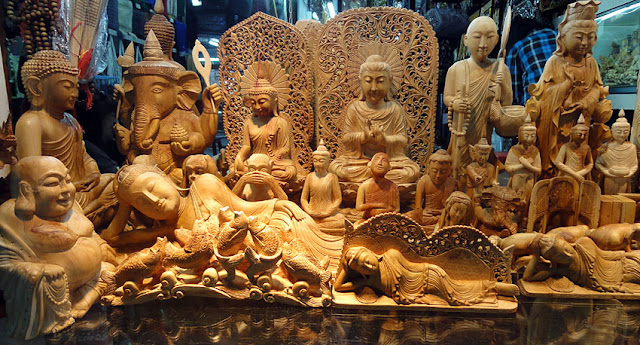Burmese Buddhist Buddha Art
The largest part of Buddhist (Buddha) Art is visualized by statues and paintings.The Buddha figures and murals in the temples in Myanmar and in particular in Bagan show just such a design.
A common feature of the Buddhist iconography of monuments executed in various materials at the same time is to be seen throughout Myanmar's entire historical development of fine art.
In the period of feudal fragmentation, Buddha images and the like became natural human proportions with a fairly large broad head and straight eyebrows plus narrow almost horizontal forming lips and cap-like hairstyle whose laps are fused into an unorganized mass.
Carved representations of this type are extremely diverse in their phonographic framework and at gigantic statues. They were more common in than in Thailand and other neighboring countries. For the most part these are freestanding fully sculptural Buddha statues.

Originally they were set up in the open air. The face and hands of the statues were painted and the monk's robe and Buddha's also painted or gilded. The face shone white the lips were red hair eyebrows and eyes black.
The simplified naive-naturalistic sculptures of gigantic proportions stand out effectively from the green groves in the background. Today you will find monumental statues only under the open sky. Most are under the roofs specially built for them called Tazaungs. The aesthetic effect of the statues which are visible only on the surface is considerably reduced in comparison with the freestanding monuments.
Overall, the faces of many sculptures began to recall the ethnic type of the Burmese, which had never been the case in earlier times in Burma. Such a transformation of Buddhist iconography can be seen in many Buddha images in the Talaungs of the Shwedagon complex. One of the variants of the spawning Burmese iconography of this group of sculptures are representations of the standing Buddha whose countenance and hairstyle are similar to those discussed above.
The clothes and the hand posture are quite unusual for Buddha: The hands of the Buddhas hung down and hold the garment, the upper part of which covered both shoulders and the arms up to the wrists. The right end of the robe is thrown over the left shoulder and fall down in numerous folds,
A common feature of the Buddhist iconography of monuments executed in various materials at the same time is to be seen throughout Myanmar's entire historical development of fine art.
In the period of feudal fragmentation, Buddha images and the like became natural human proportions with a fairly large broad head and straight eyebrows plus narrow almost horizontal forming lips and cap-like hairstyle whose laps are fused into an unorganized mass.
Carved representations of this type are extremely diverse in their phonographic framework and at gigantic statues. They were more common in than in Thailand and other neighboring countries. For the most part these are freestanding fully sculptural Buddha statues.

Originally they were set up in the open air. The face and hands of the statues were painted and the monk's robe and Buddha's also painted or gilded. The face shone white the lips were red hair eyebrows and eyes black.
The simplified naive-naturalistic sculptures of gigantic proportions stand out effectively from the green groves in the background. Today you will find monumental statues only under the open sky. Most are under the roofs specially built for them called Tazaungs. The aesthetic effect of the statues which are visible only on the surface is considerably reduced in comparison with the freestanding monuments.
Gigantic Buddha sculptures
Buddha sculptures with bud-like hairstyle and gold-plated ornamental ribbon became softer and more natural and the lips fuller.Overall, the faces of many sculptures began to recall the ethnic type of the Burmese, which had never been the case in earlier times in Burma. Such a transformation of Buddhist iconography can be seen in many Buddha images in the Talaungs of the Shwedagon complex. One of the variants of the spawning Burmese iconography of this group of sculptures are representations of the standing Buddha whose countenance and hairstyle are similar to those discussed above.
The clothes and the hand posture are quite unusual for Buddha: The hands of the Buddhas hung down and hold the garment, the upper part of which covered both shoulders and the arms up to the wrists. The right end of the robe is thrown over the left shoulder and fall down in numerous folds,

Comments
Post a Comment